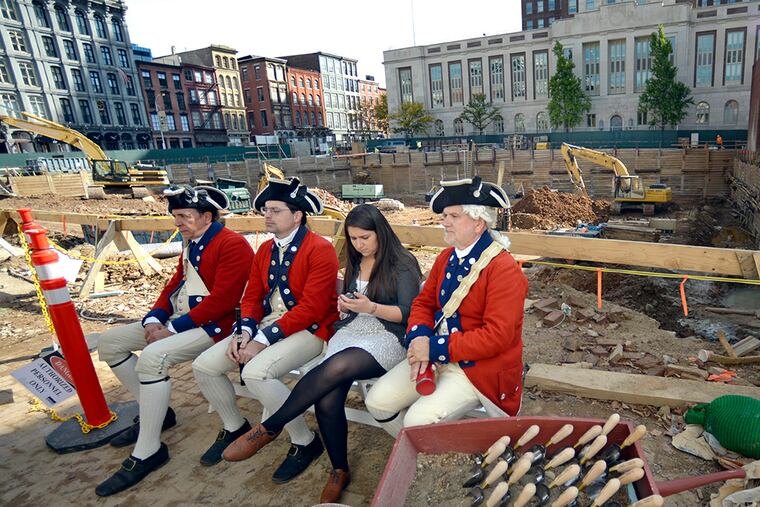Ground is broken for American Revolution museum
An array of politicians, benefactors, and nonprofit leaders gathered Thursday morning beneath a vast party tent beside a very deep hole along South Third Street to celebrate the symbolic groundbreaking of the Museum of the American Revolution.

An array of politicians, benefactors, and nonprofit leaders gathered Thursday morning beneath a vast party tent beside a very deep hole along South Third Street to celebrate the symbolic groundbreaking of the Museum of the American Revolution.
When the deep hole is filled and the $119 million building opens in two years, it will be, officials believe, the nation's first museum to tell the whole story of the American Revolution - from the disgruntled grumbling over British taxes in the 1760s through the desperate days of the Continental Army in the 1770s and on to eventual independence in the 1780s.
"This is a very, very important asset for America that we're soon to build," said Sen. Pat Toomey (R., Pa.). Sen. Robert P. Casey Jr. (D., Pa.) called the museum "a monument to freedom [that] will also be a testament, I believe, to the American character."
The Washington author and pundit Cokie Roberts, who delivered brief keynote remarks, called it "a great day, a really exciting moment, and it all started with a tent."
That tent, not the one she was standing under but the much smaller field tent used by George Washington throughout the Revolutionary War, is the centerpiece of the museum's collection of artifacts.
Philanthropist H.F. "Gerry" Lenfest, the prime advocate and benefactor for the museum, called the groundbreaking "a milestone" and invited all to return in two years for the opening.
Lenfest, the owner and publisher of The Inquirer, the Philadelphia Daily News, and Philly.com, has advocated for the museum for more than a decade. He was instrumental, with former Gov. Ed Rendell - also present Thursday - in engineering an agreement with Independence National Historical Park that allowed the museum to acquire park property at Third and Chestnut Street.
Museum president and chief executive Michael C. Quinn said Thursday that construction had now been "fully funded" and that no debt would be necessary to complete the project.
The building, designed by Robert A.M. Stern Architects, will contain an array of artifacts, largely the former holdings of the Valley Forge Historical Society, acquired years ago.
The society's holdings, in turn, grew from the collection of the Rev. W. Herbert Burk, a Norristown minister, who tracked down Washington's tent and bought it in 1909.
Quinn has said that apart from the tent's iconic pedigree, it may be "the only surviving tent from the Revolution."
Roberts, author of the best-selling history Founding Mothers, used the tale of the tent's survival to tease out some of what she considered hidden stories of women and enslaved Africans tied to the nation's birth.
After Washington's death, she noted, Martha Washington preserved the tent and bequeathed it to her grandson, George Washington Park Custis. He eventually moved it to Arlington House, his estate, and left it to his daughter, Mary, wife of Robert E. Lee. Mary Lee left Arlington as the Civil War loomed and entrusted the tent and other presidential artifacts to her enslaved servant Selina Gray.
Gray protected what she could, but the tent was seized by Union troops and carted off to storage in the U.S. Patent Office, where it remained while the Lee family fought for its return after the war.
President William McKinley finally agreed to give the tent back to the Lee family, which promptly sold it to Burk.
"That's why," Roberts said, "we have a big hole in the ground today."
215-854-5594 @SPSalisbury